MRI sequences: Difference between revisions
Tarek Nafee (talk | contribs) |
No edit summary |
||
| (34 intermediate revisions by 3 users not shown) | |||
| Line 2: | Line 2: | ||
{{SI}} | {{SI}} | ||
{{CMG}};{{AE}}{{AY}} | {{CMG}};{{AE}}{{AY}} | ||
==Overview== | ==Overview== | ||
*[[MRI]] is basically a huge magnet that emits energy ([[Radio-frequency]] pulse) into the body. | *[[MRI]] is basically a huge magnet that emits energy ([[Radio-frequency]] pulse) into the body. | ||
| Line 49: | Line 48: | ||
*Tissues have the same densities as in T1 except that moving blood is bright. | *Tissues have the same densities as in T1 except that moving blood is bright. | ||
*Useful in assessing hypervascular lesions (e.g. [[hemangiomas]], [[lymphangiomas]]) | *Useful in assessing hypervascular lesions (e.g. [[hemangiomas]], [[lymphangiomas]]) | ||
{| class="wikitable" | |||
{| | ![[Image:T1_c_acoustic-schwannoma-14.jpg|center|300px|thumb|T1+C MRI brain showing acuostic schwanoma - Case courtesy of A.Prof Frank Gaillard, <a href="https://radiopaedia.org/">Radiopaedia.org</a>. From the case <a href="https://radiopaedia.org/cases/28272">rID: 28272</a> ]] | ||
![[Image:T1_acoustic-schwannoma-14.jpg|center|300px|thumb|T1 MRI brain (without contrast) showing acuostic schwanoma - Case courtesy of A.Prof Frank Gaillard, <a href="https://radiopaedia.org/">Radiopaedia.org</a>. From the case <a href="https://radiopaedia.org/cases/28272">rID: 28272</a> ]] | |||
|} | |} | ||
===T2 weighted imaging:=== | ===T2 weighted imaging:=== | ||
Tissue densities reflex T2 which is the transverse relaxation time of the Net Magnetic Vector (NMV).<ref name="urlT2 weighted image | Radiology Reference Article | Radiopaedia.org">{{cite web |url=https://radiopaedia.org/articles/t2-weighted-image |title=T2 weighted image | Radiology Reference Article | Radiopaedia.org |format= |work= |accessdate=}}</ref> | Tissue densities reflex T2 which is the transverse relaxation time of the Net Magnetic Vector (NMV).<ref name="urlT2 weighted image | Radiology Reference Article | Radiopaedia.org">{{cite web |url=https://radiopaedia.org/articles/t2-weighted-image |title=T2 weighted image | Radiology Reference Article | Radiopaedia.org |format= |work= |accessdate=}}</ref> | ||
| Line 80: | Line 73: | ||
====Important note:==== | ====Important note:==== | ||
*T2 weighted imaging is not the best sequence for assessing lesions close to [[Ventricles|brain ventricles]] both will look bright. | *T2 weighted imaging is not the best sequence for assessing lesions close to [[Ventricles|brain ventricles]] both will look bright. | ||
{| class="wikitable" | |||
![[Image:T2_N.jpg|center|300px|thumb|T2 weighted normal MRI brain - Case courtesy of Dr Ahmed Abd Rabou, <a href="https://radiopaedia.org/">Radiopaedia.org</a>. From the case <a href="https://radiopaedia.org/cases/22973">rID: 22973</a> ]] | |||
![[Image:Acute-disseminated-encephalomyelitis-5.jpg|center|300px|thumb|T2 weighted MRI brain showing acute disseminated encephalomyelitis - Case courtesy of A.Prof Frank Gaillard, <a href="https://radiopaedia.org/">Radiopaedia.org</a>. From the case <a href="https://radiopaedia.org/cases/37704">rID: 37704</a> ]] | |||
|} | |} | ||
===Diffusion-weighted imaging (DWI):=== | |||
DWI specifically detects the motion of protons in water molecules. | DWI specifically detects the motion of protons in water molecules. | ||
| Line 98: | Line 90: | ||
Fluid restricted areas appear bright. So, it’s most useful in assessing ischemia (e.g. [[stroke]]) | Fluid restricted areas appear bright. So, it’s most useful in assessing ischemia (e.g. [[stroke]]) | ||
{| class="wikitable" | |||
![[Image:DWI_N.jpg|center|300px|thumb|Normal DWI brain MRI - Case courtesy of Dr Bruno Di Muzio, <a href="https://radiopaedia.org/">Radiopaedia.org</a>. From the case <a href="https://radiopaedia.org/cases/39311">rID: 39311</a>]] | |||
![[Image:DWI_left-middle-cerebral-artery-territory-infarct.jpg|center|300px|thumb|DWI MRI brain (without contrast) showing middle cerebral artery territory stroke - Case courtesy of Dr Gagandeep Choudhary, <a href="https://radiopaedia.org/">Radiopaedia.org</a>. From the case <a href="https://radiopaedia.org/cases/12093">rID: 12093</a> ]] | |||
|} | |||
===Fluid Attenuation Inversion Recovery (FLAIR):=== | ===Fluid Attenuation Inversion Recovery (FLAIR):=== | ||
This sequence attenuates signals from fluids (e.g [[CSF]]) and thus is helpful in detecting lesions normally covered by [[CSF]] (in [[brain]] and [[spinal cord]]) | This sequence attenuates signals from fluids (e.g [[CSF]]) and thus is helpful in detecting lesions normally covered by [[CSF]] (in [[brain]] and [[spinal cord]]) | ||
| Line 119: | Line 111: | ||
Best used in assessing lesions near [[ventricles]] the lesion can be easily discriminated from [[CSF]]. | Best used in assessing lesions near [[ventricles]] the lesion can be easily discriminated from [[CSF]]. | ||
{| class="wikitable" | |||
![[Image:FLAIR_N.jpg|center|300px|thumb|Normal FLAIR MRI brain - Case courtesy of Dr Bruno Di Muzio, <a href="https://radiopaedia.org/">Radiopaedia.org</a>. From the case <a href="https://radiopaedia.org/cases/39311">rID: 39311</a> ]] | |||
![[Image:FLAIR_acute-disseminated-encephalomyelitis-4.jpg|center|300px|thumb|FLAIR MRI brain showing acute disseminated encephalomyeilitis - Case courtesy of Dr Ahmed Abd Rabou, <a href="https://radiopaedia.org/">Radiopaedia.org</a>. From the case <a href="https://radiopaedia.org/cases/22973">rID: 22973</a> ]] | |||
|} | |||
===Proton density weighted imaging:=== | ===Proton density weighted imaging:=== | ||
It relies primarily on the density of the protons. So, Tissues with higher density give brighter signals. | It relies primarily on the density of the protons. So, Tissues with higher density give brighter signals. | ||
| Line 138: | Line 130: | ||
Excellent in assessing [[joints]] as they can discriminate between fluid, [[hyaline cartilage]] & [[fibrocartilage]]. | Excellent in assessing [[joints]] as they can discriminate between fluid, [[hyaline cartilage]] & [[fibrocartilage]]. | ||
{| class="wikitable" | |||
![[Image:PD_N.jpg|center|300px|thumb|PD MRI of the wrist - Case courtesy of Dr Andrew Dixon, <a href="https://radiopaedia.org/">Radiopaedia.org</a>. From the case <a href="https://radiopaedia.org/cases/42982">rID: 42982</a>]] | |||
![[Image:PD_knee-mri-sagittal-pd-1.jpg|center|300px|thumb|PD MRI of the knee joint - Case courtesy of Dr Andrew Dixon, <a href="https://radiopaedia.org/">Radiopaedia.org</a>. From the case <a href="https://radiopaedia.org/cases/22993">rID: 22993</a>]] | |||
|} | |||
===Short Tau Inversion Recovery (STIR)=== | ===Short Tau Inversion Recovery (STIR)=== | ||
| Line 156: | Line 152: | ||
Most useful in assessing fluid filled spaces. | Most useful in assessing fluid filled spaces. | ||
This video summarizes some important aspects and uses of common MRI sequences. | [[Image:Posterior-lumbar-subcutaneous-oedema.JPG|center|300px|thumb|STIR MRI showing lumbar subcutaneous edema - Case courtesy of Dr Ayush Goel, <a href="https://radiopaedia.org/">Radiopaedia.org</a>. From the case <a href="https://radiopaedia.org/cases/23477">rID: 23477</a>]] | ||
'''This video summarizes some important aspects and uses of common MRI sequences.''' | |||
{{#ev:youtube|mOt2FeGHjaY}} | {{#ev:youtube|mOt2FeGHjaY}} | ||
==References== | |||
Latest revision as of 15:42, 7 July 2020
|
WikiDoc Resources for MRI sequences |
|
Articles |
|---|
|
Most recent articles on MRI sequences Most cited articles on MRI sequences |
|
Media |
|
Powerpoint slides on MRI sequences |
|
Evidence Based Medicine |
|
Clinical Trials |
|
Ongoing Trials on MRI sequences at Clinical Trials.gov Trial results on MRI sequences Clinical Trials on MRI sequences at Google
|
|
Guidelines / Policies / Govt |
|
US National Guidelines Clearinghouse on MRI sequences NICE Guidance on MRI sequences
|
|
Books |
|
News |
|
Commentary |
|
Definitions |
|
Patient Resources / Community |
|
Patient resources on MRI sequences Discussion groups on MRI sequences Patient Handouts on MRI sequences Directions to Hospitals Treating MRI sequences Risk calculators and risk factors for MRI sequences
|
|
Healthcare Provider Resources |
|
Causes & Risk Factors for MRI sequences |
|
Continuing Medical Education (CME) |
|
International |
|
|
|
Business |
|
Experimental / Informatics |
Editor-In-Chief: C. Michael Gibson, M.S., M.D. [1];Associate Editor(s)-in-Chief: Ahmed Younes M.B.B.CH [2]
Overview
- MRI is basically a huge magnet that emits energy (Radio-frequency pulse) into the body.
- Radiofrequency pulse causes the protons in H+ atoms to spin in different directions from which it used to spin.
- When the pulse stops .. the protons go back to spinning in the normal direction .. it releases energy.
- As tissues vary in a number of protons in it .. the energy emitted differ from tissue to tissue.
- Interpreting this energy using certain techniques enables us to represent every tissue in a unique density.
We are going to discuss some of the most commonly used sequences and when to use each one of them.
This video simplifies the concept of T1 and T2 relaxation times and their application in MRI.
{{#ev:youtube|Z2xpY_hkSBY}}
MRI Sequences
- An MRI sequence is a number of radio-frequency pulses (from the machine) and gradients that result (from protons in the body) in a set of images with a particular appearance.
- Each sequence gives different tissues different intensities and best used in assessing certain pathology.
T1 weighted imaging:
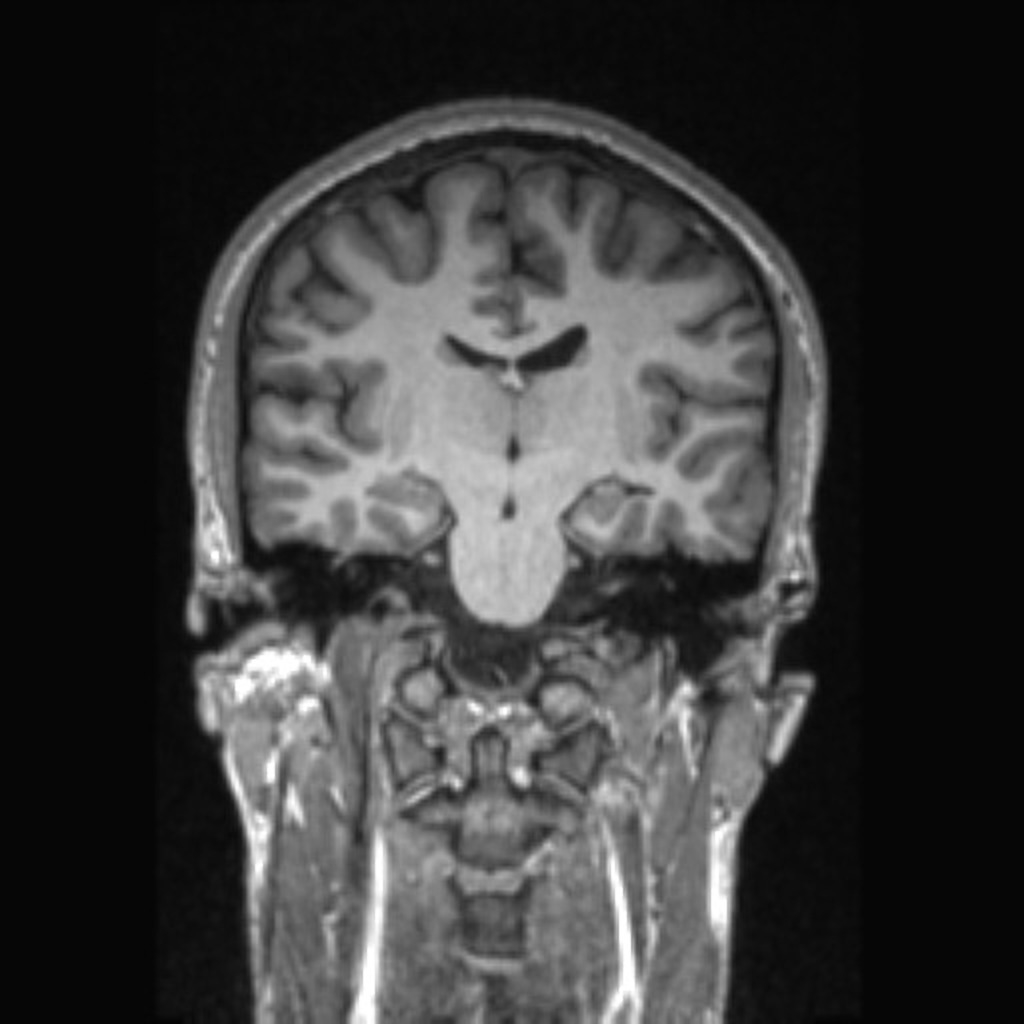 |
Tissue densities reflex T1 which is the longitudinal relaxation time of the Net Magnetic Vector (NMV).[1]
When using T1 weighted imaging .. the tissues give the following densities:
- Fat: bright
- Muscle: gray
- Fluid: dark
- Moving blood: dark
- Bone: dark
- Air: dark
- Brain:
- Gray matter: gray
- White matter: bright
T1 is best used in assessing the anatomy as the image resembles the tissue macroscopically.
T1+Contrast (gadolinium)
- Injecting contrast material (gadolinium) increases T1 signal from moving blood and thus allows detection of highly vascular lesions.
- Tissues have the same densities as in T1 except that moving blood is bright.
- Useful in assessing hypervascular lesions (e.g. hemangiomas, lymphangiomas)
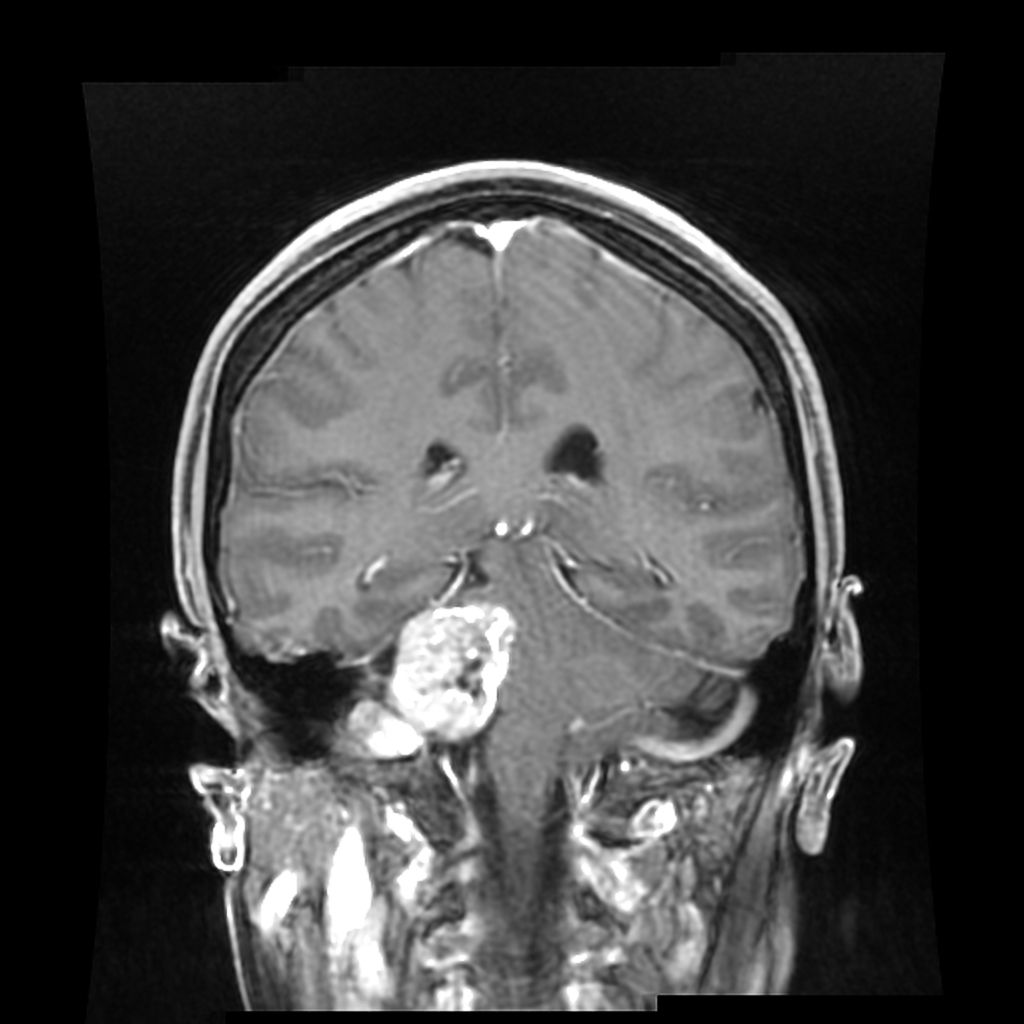 |
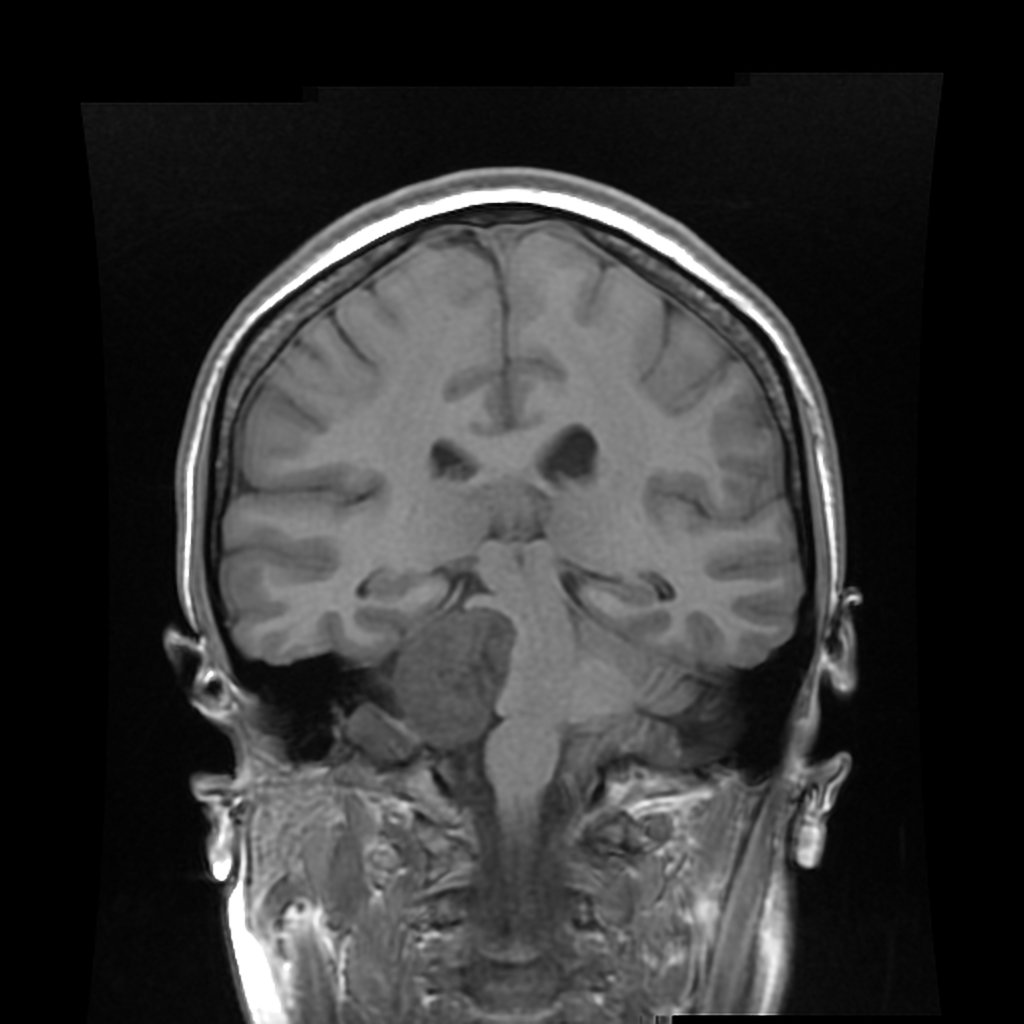 |
|---|
T2 weighted imaging:
Tissue densities reflex T2 which is the transverse relaxation time of the Net Magnetic Vector (NMV).[2]
When using T2 weighted imaging .. the tissues give the following densities:
- Fat: bright
- Muscle: gray
- Fluid: dark
- Moving blood: dark
- Bone: dark
- Air: dark
- Brain:
- Gray matter: gray
- White matter: bright
Most pathologies have increased fluid content of the tissue as a part of the inflammatory process. Thus, lesions appear brighter. Used as in T1 weighted imaging in assessing the anatomy & most lesions in the body.
Important note:
- T2 weighted imaging is not the best sequence for assessing lesions close to brain ventricles both will look bright.
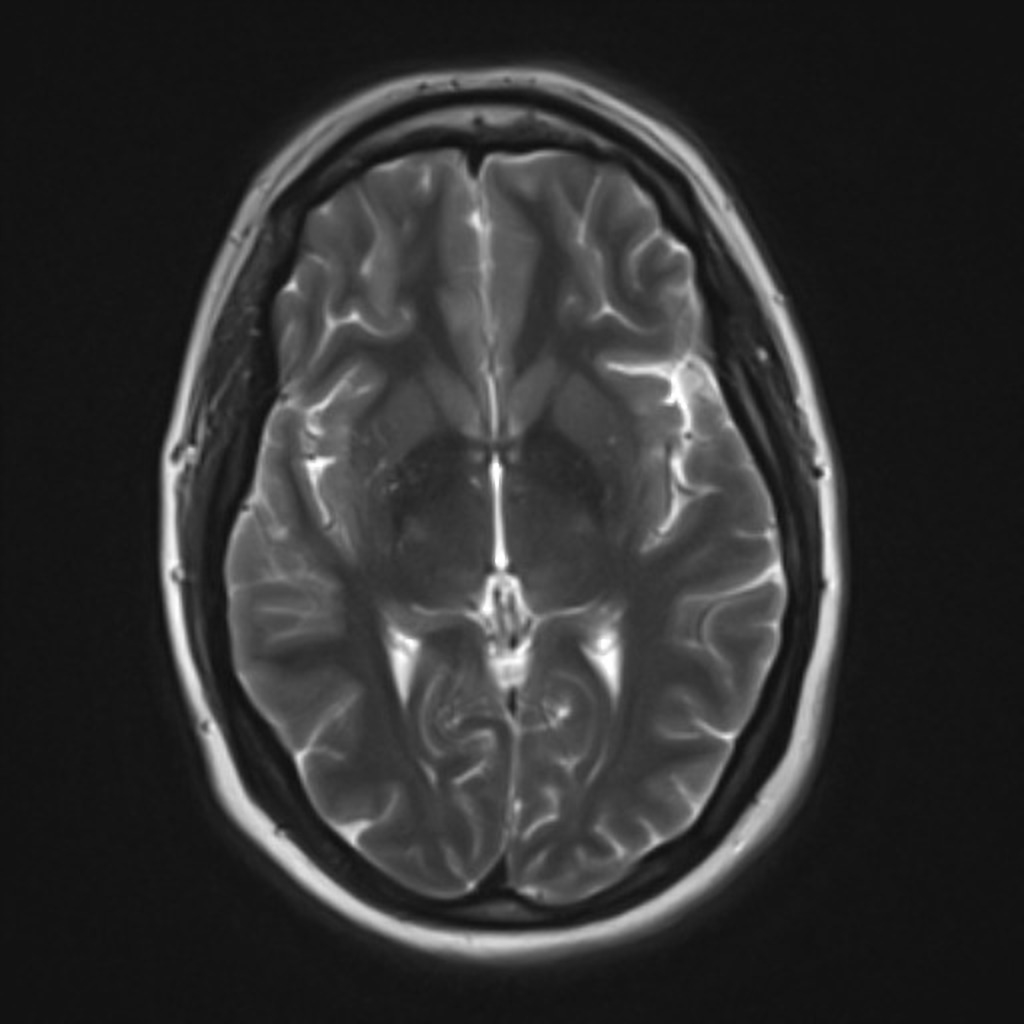 |
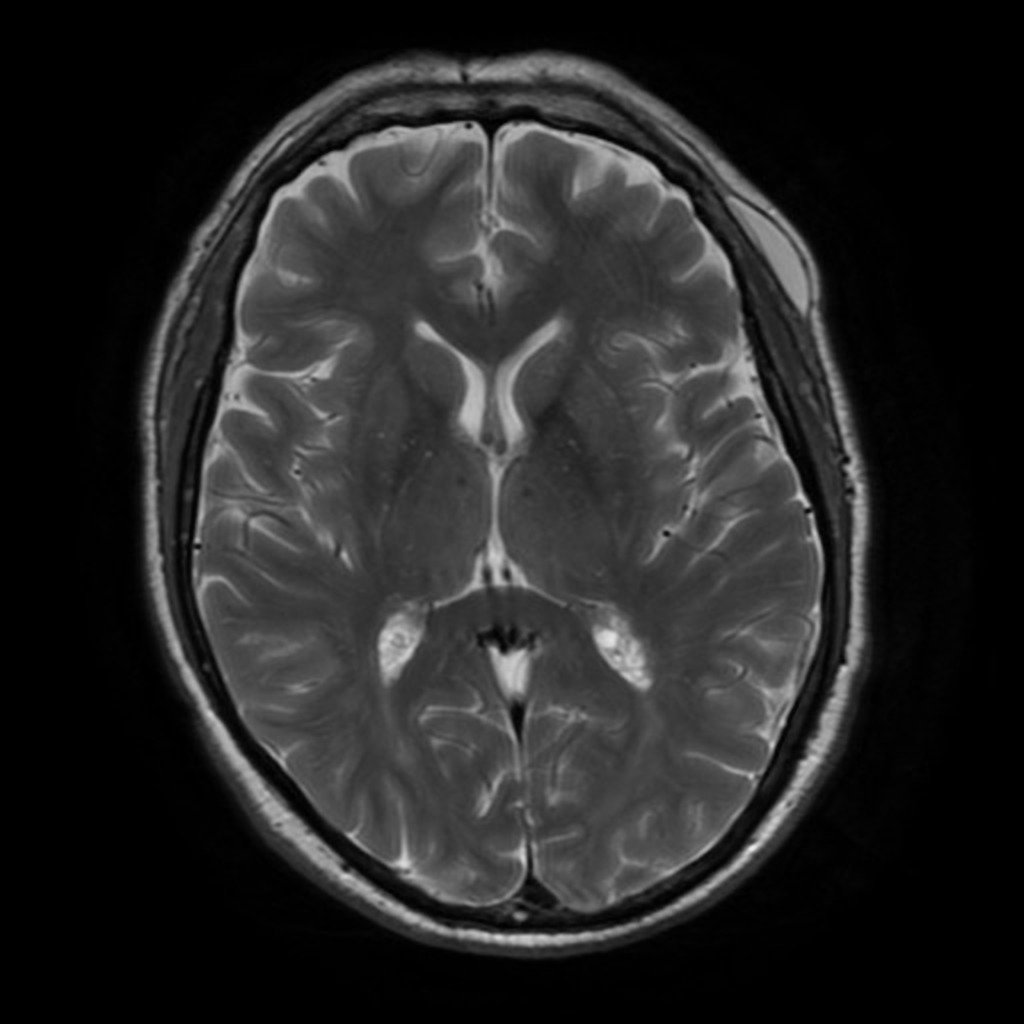 |
|---|
Diffusion-weighted imaging (DWI):
DWI specifically detects the motion of protons in water molecules.
When using DWI weighted imaging .. the tissues give the following densities:
- Fat: low signal
- Muscle: gray
- Fluid: dark
- Brain:
- Gray matter: gray
- White matter: hypodense compared to gray matter
Fluid restricted areas appear bright. So, it’s most useful in assessing ischemia (e.g. stroke)
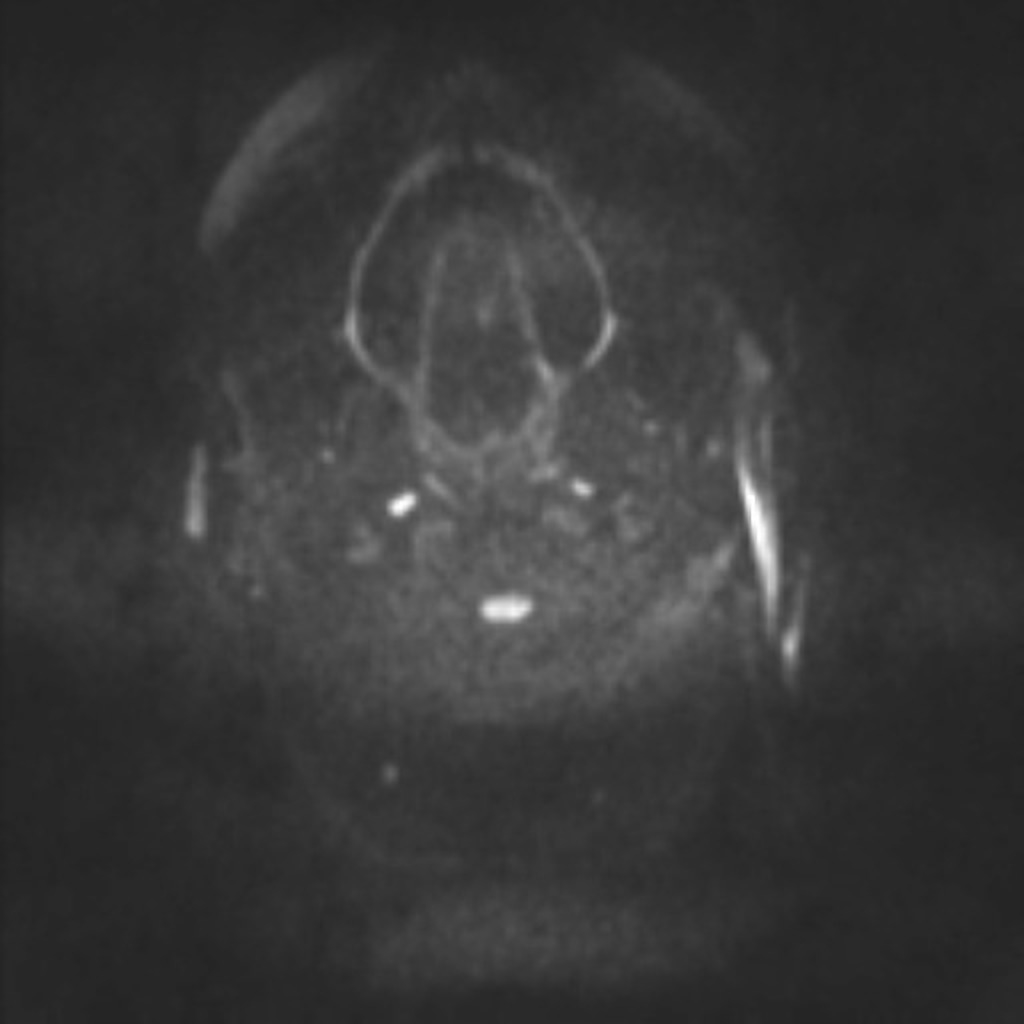 |
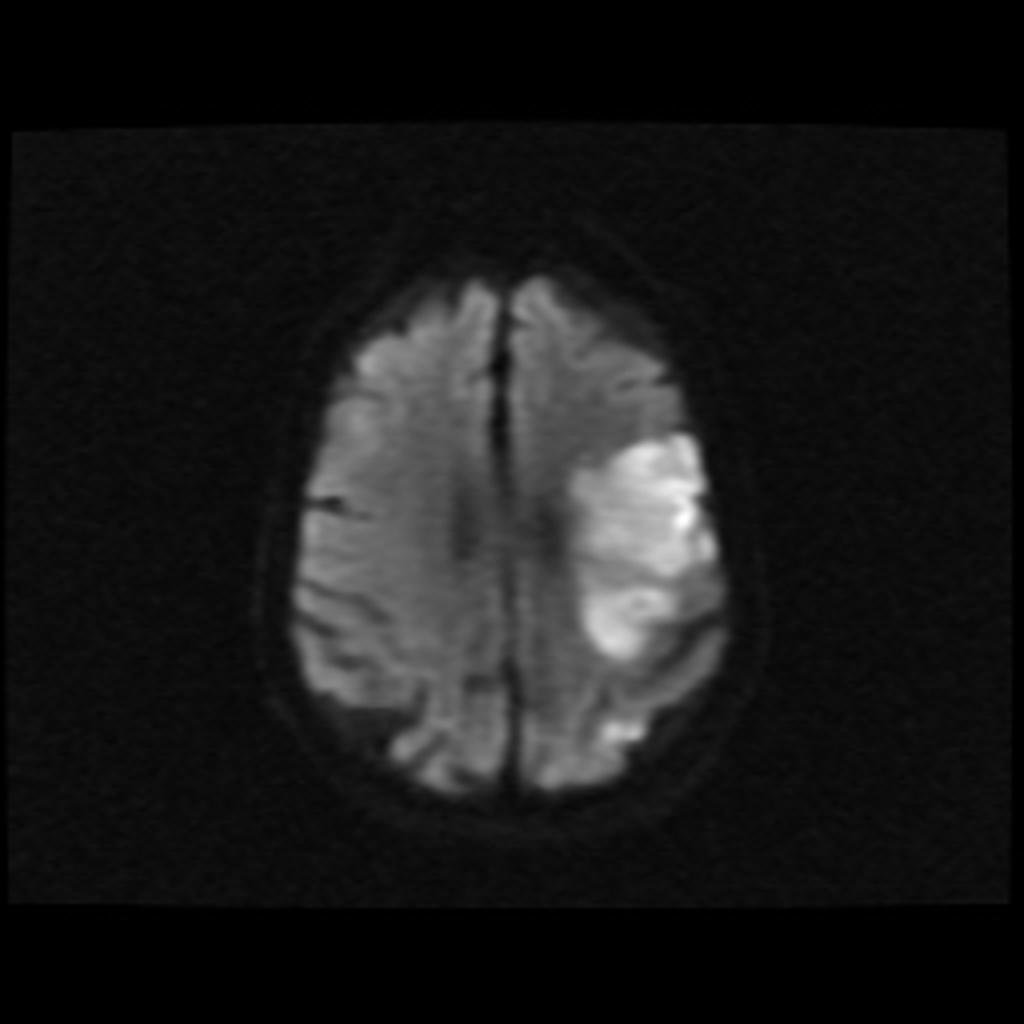 |
|---|
Fluid Attenuation Inversion Recovery (FLAIR):
This sequence attenuates signals from fluids (e.g CSF) and thus is helpful in detecting lesions normally covered by CSF (in brain and spinal cord)
Tissues acquire the same densities as T2 weighted imaging except for that fluid appears dark.
- Fat: bright
- Muscle: gray
- Fluid: dark
- Bone: dark
- Air: dark
- Brain:
- Gray matter: gray
- White matter: darker than gray matter
Best used in assessing lesions near ventricles the lesion can be easily discriminated from CSF.
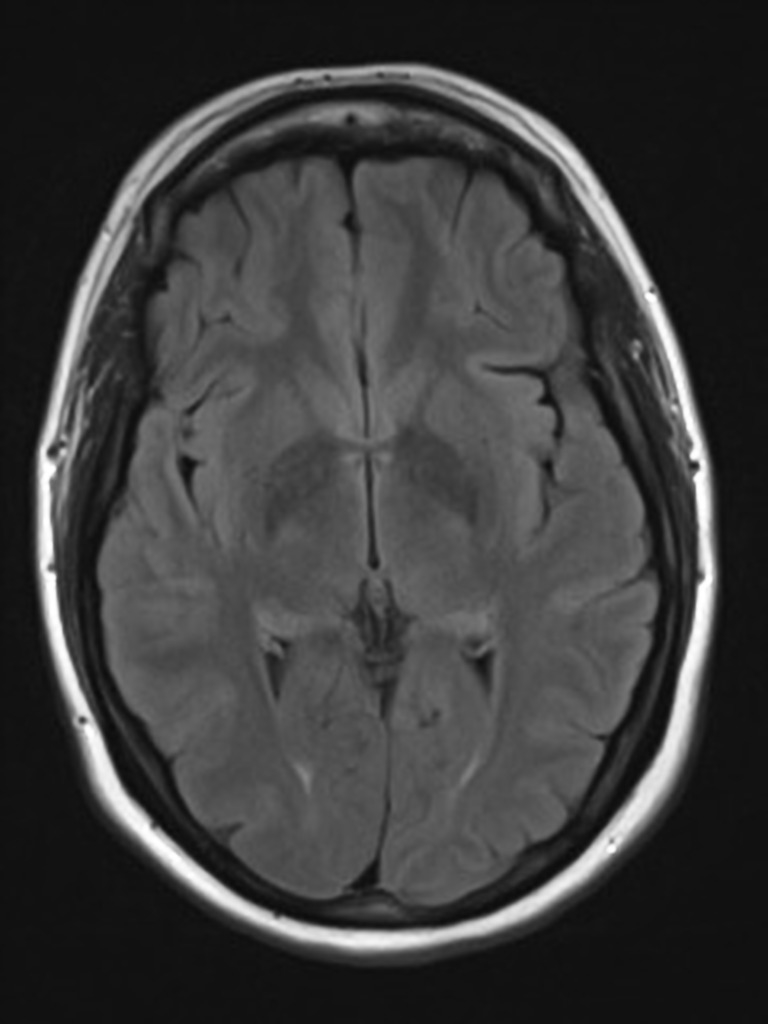 |
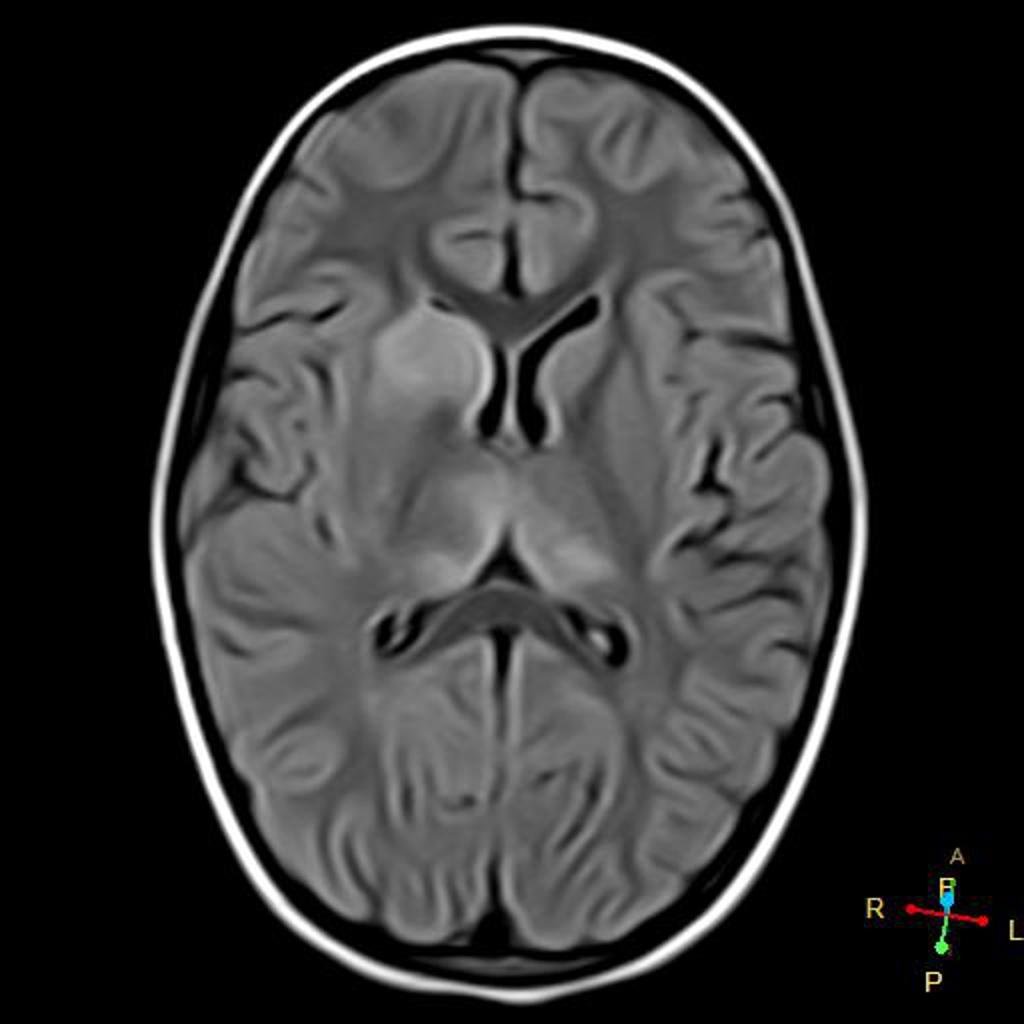 |
|---|
Proton density weighted imaging:
It relies primarily on the density of the protons. So, Tissues with higher density give brighter signals.
When using PD-weighted imaging .. the tissues give the following densities:
- Fat: bright
- Muscle: gray
- Fluid: bright
- Bone: dark
- Air: dark
- Hyaline cartilage: gray
- Fibrocartilage: dark
Excellent in assessing joints as they can discriminate between fluid, hyaline cartilage & fibrocartilage.
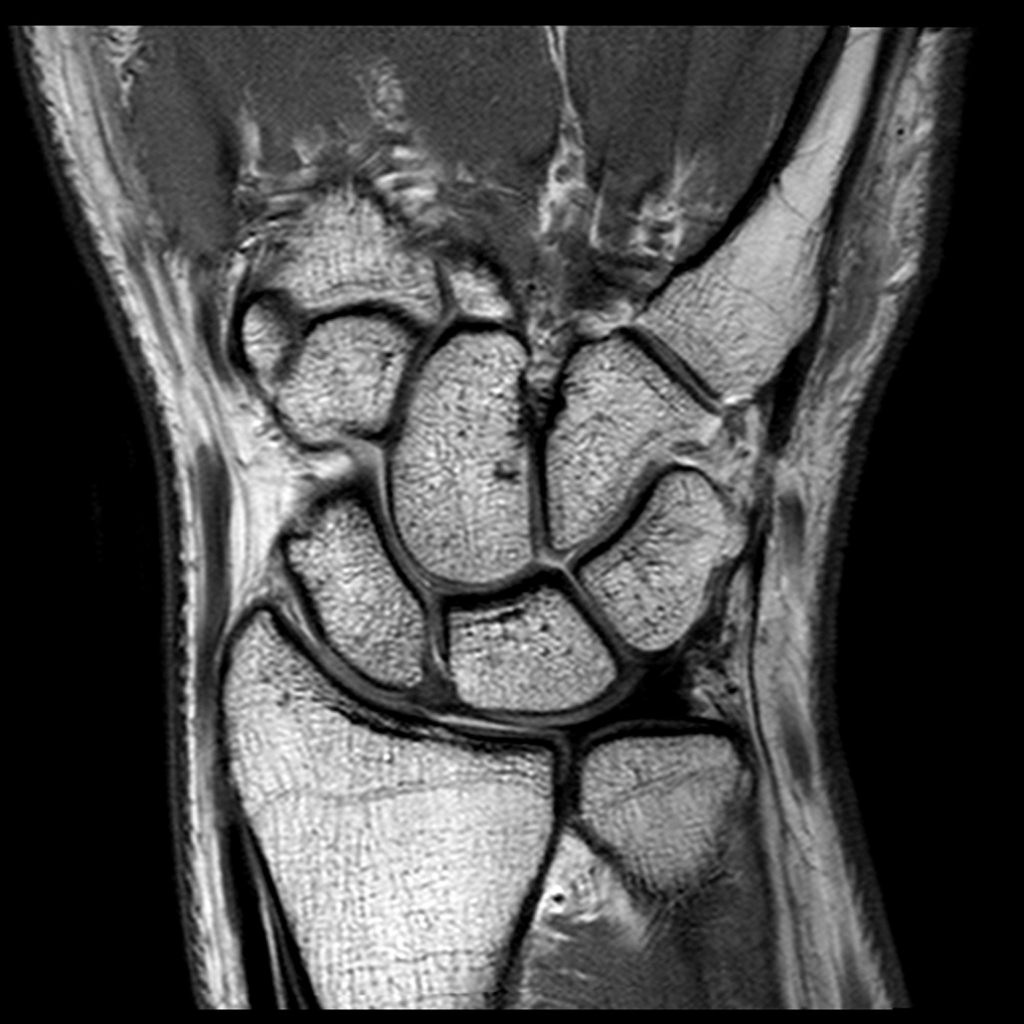 |
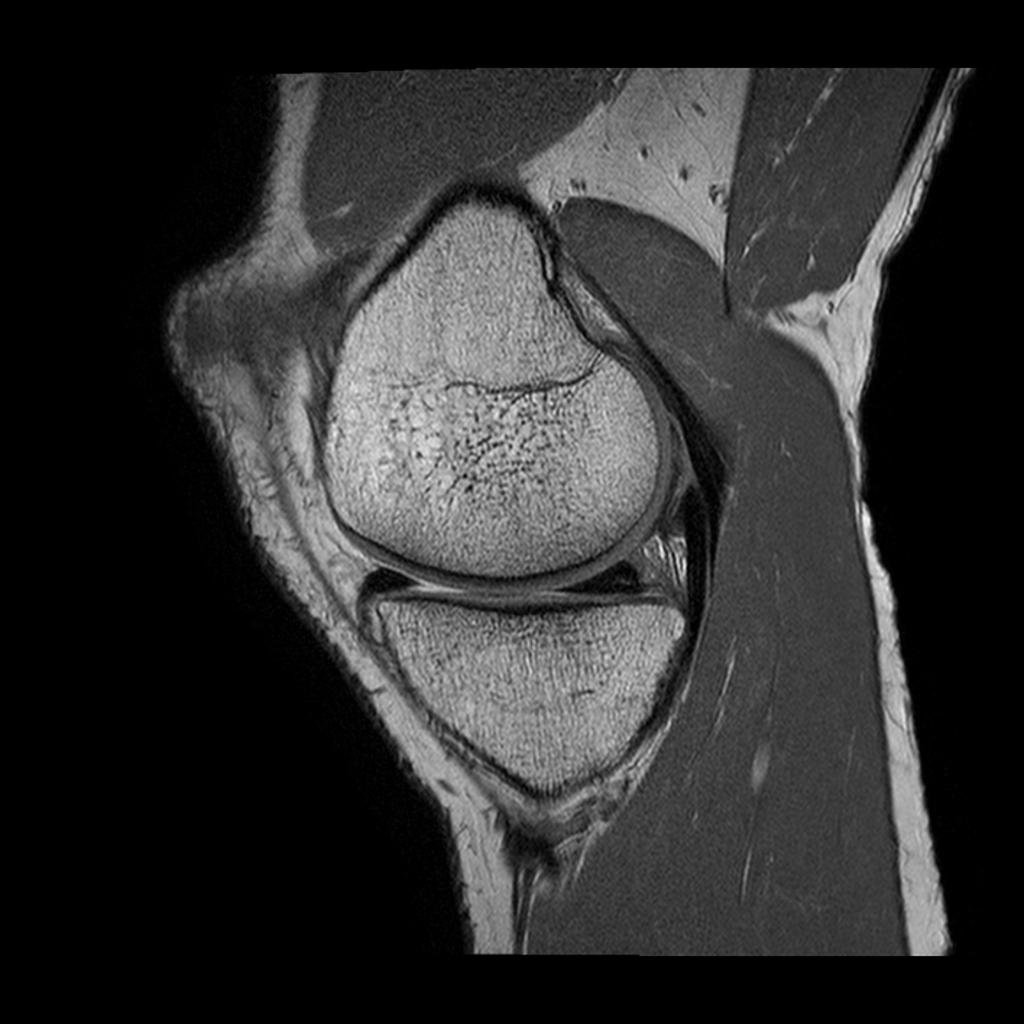 |
|---|
Short Tau Inversion Recovery (STIR)
Similar to FLAIR sequence, STIR suppresses signals from fat tissue.[3]
STIR can not be used post gadolinium injection as gadolinium has T1 in the same range of fat & eventually signals from it will be attenuated.
When using STIR imaging .. the tissues give the following densities:
- Fat: dark
- Muscle: darker than fat
- Fluid: very bright
- Bone: dark
- Air: dark
- Brain:
- Gray matter: gray
- White matter: darker than gray matter
Most useful in assessing fluid filled spaces.
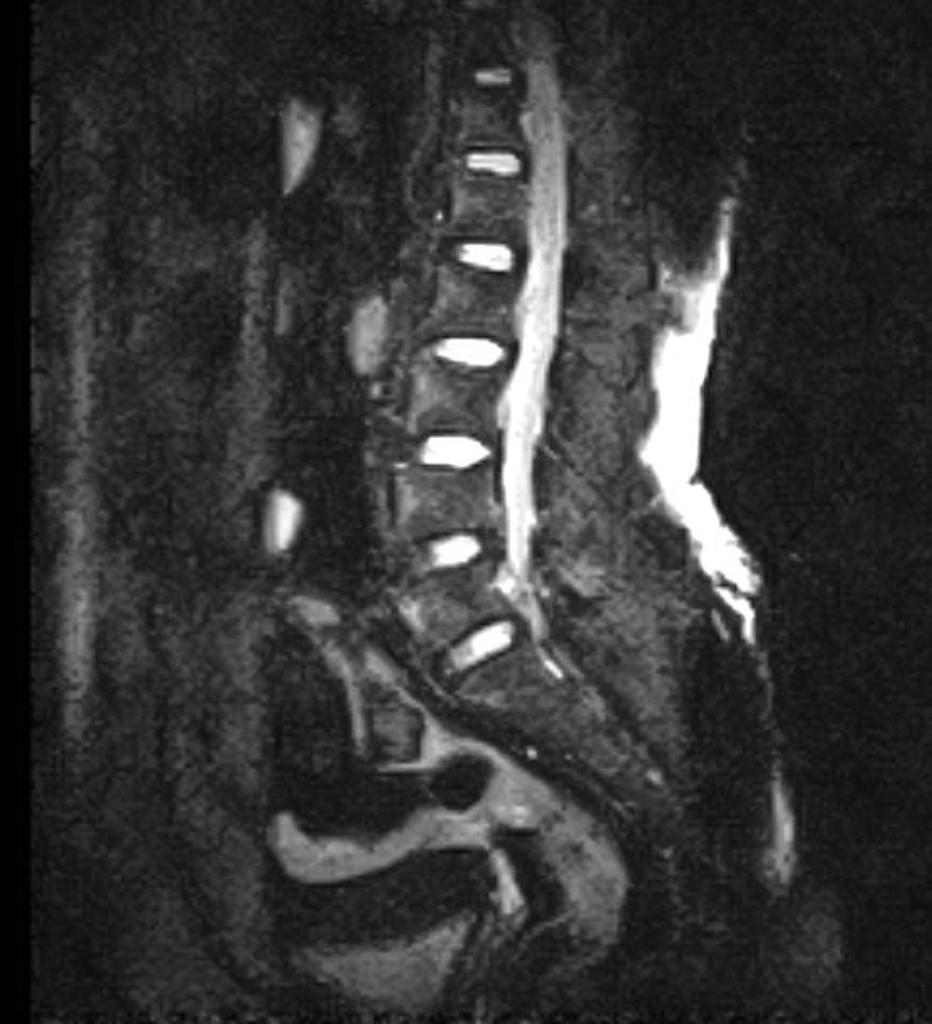
This video summarizes some important aspects and uses of common MRI sequences.
{{#ev:youtube|mOt2FeGHjaY}}